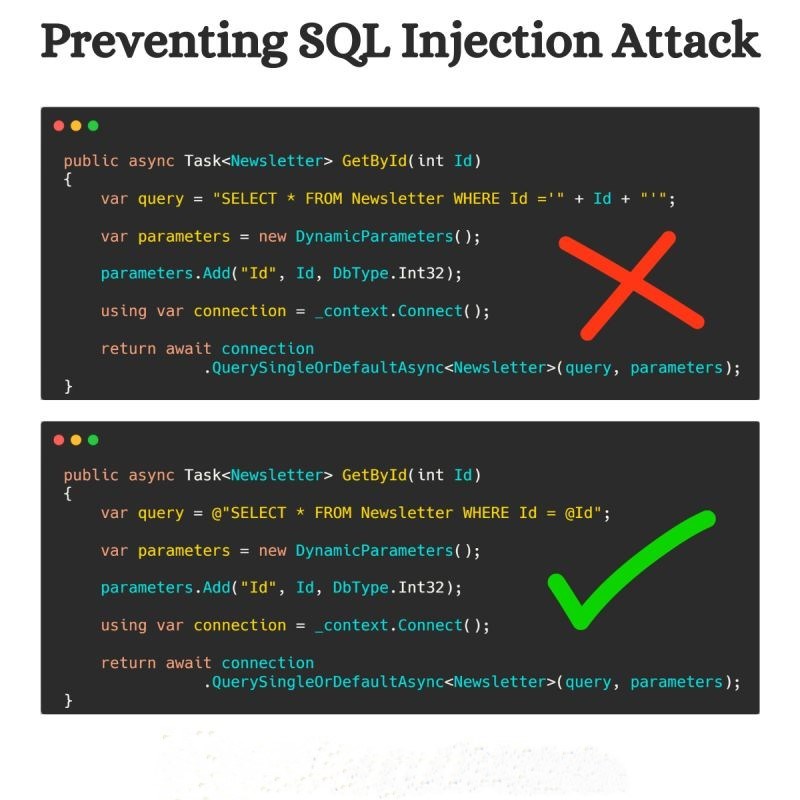SQL Injection and Prevention in C#
SQL Injection is a common security vulnerability that occurs when an attacker manipulates SQL queries by injecting malicious input, potentially allowing unauthorized access to a database.
1. How SQL Injection Works
SQL injection occurs when user input is concatenated directly into SQL queries. Consider the following example:
string query = "SELECT * FROM Users WHERE Username = '" + username + "' AND Password = '" + password + "'";
SqlCommand cmd = new SqlCommand(query, conn);
If an attacker inputs:
username: ' OR '1'='1
password: anything
The query becomes:
SELECT * FROM Users WHERE Username = '' OR '1'='1' AND Password = 'anything'
Since '1'='1' always evaluates to true, the query bypasses authentication.
2. Preventing SQL Injection in C#
2.1. Use Parameterized Queries (Recommended)
Using SqlCommand with parameters ensures that user input is treated as data, not SQL code.
Example:
string query = "SELECT * FROM Users WHERE Username = @username AND Password = @password";
using (SqlCommand cmd = new SqlCommand(query, conn))
{
cmd.Parameters.AddWithValue("@username", username);
cmd.Parameters.AddWithValue("@password", password);
SqlDataReader reader = cmd.ExecuteReader();
}
- Prevents SQL injection because input is treated as a value.
- Avoid
.AddWithValue()for complex types (e.g.,DateTime), as it may cause implicit conversion issues.
2.2. Use Stored Procedures
Stored procedures execute predefined SQL logic, reducing the risk of injection.
Example:
CREATE PROCEDURE ValidateUser
@username NVARCHAR(50),
@password NVARCHAR(50)
AS
BEGIN
SELECT * FROM Users WHERE Username = @username AND Password = @password
END
using (SqlCommand cmd = new SqlCommand("ValidateUser", conn))
{
cmd.CommandType = CommandType.StoredProcedure;
cmd.Parameters.AddWithValue("@username", username);
cmd.Parameters.AddWithValue("@password", password);
SqlDataReader reader = cmd.ExecuteReader();
}
2.3. Use ORM (Entity Framework, Dapper)
ORMs like Entity Framework (EF) and Dapper abstract direct SQL queries, making them safer.
Using Entity Framework (EF)
var user = dbContext.Users
.FirstOrDefault(u => u.Username == username && u.Password == password);
EF generates parameterized queries automatically.
Using Dapper
string sql = "SELECT * FROM Users WHERE Username = @Username AND Password = @Password";
var user = connection.QueryFirstOrDefault<User>(sql, new { Username = username, Password = password });
2.4. Input Validation & Escaping
- Allowlist validation: Ensure input meets expected formats (e.g., alphanumeric for usernames).
- Escape special characters: If necessary, manually escape single quotes (
'→'').
2.5. Principle of Least Privilege
- Avoid using
sa(sysadmin) accounts for database access. - Restrict user roles and deny direct access to sensitive tables.
2.6. Web Application Firewall (WAF)
Use a WAF to block suspicious requests containing SQL injection patterns.
3. Summary
Do it to prevent SQL Injection:
- Use Parameterized Queries
- Use Stored Procedures
- Use ORMs like Entity Framework/Dapper
- Validate user input
Don't:
- Concatenate user input into SQL queries
- Use dynamic SQL with string interpolation




Leave Comment